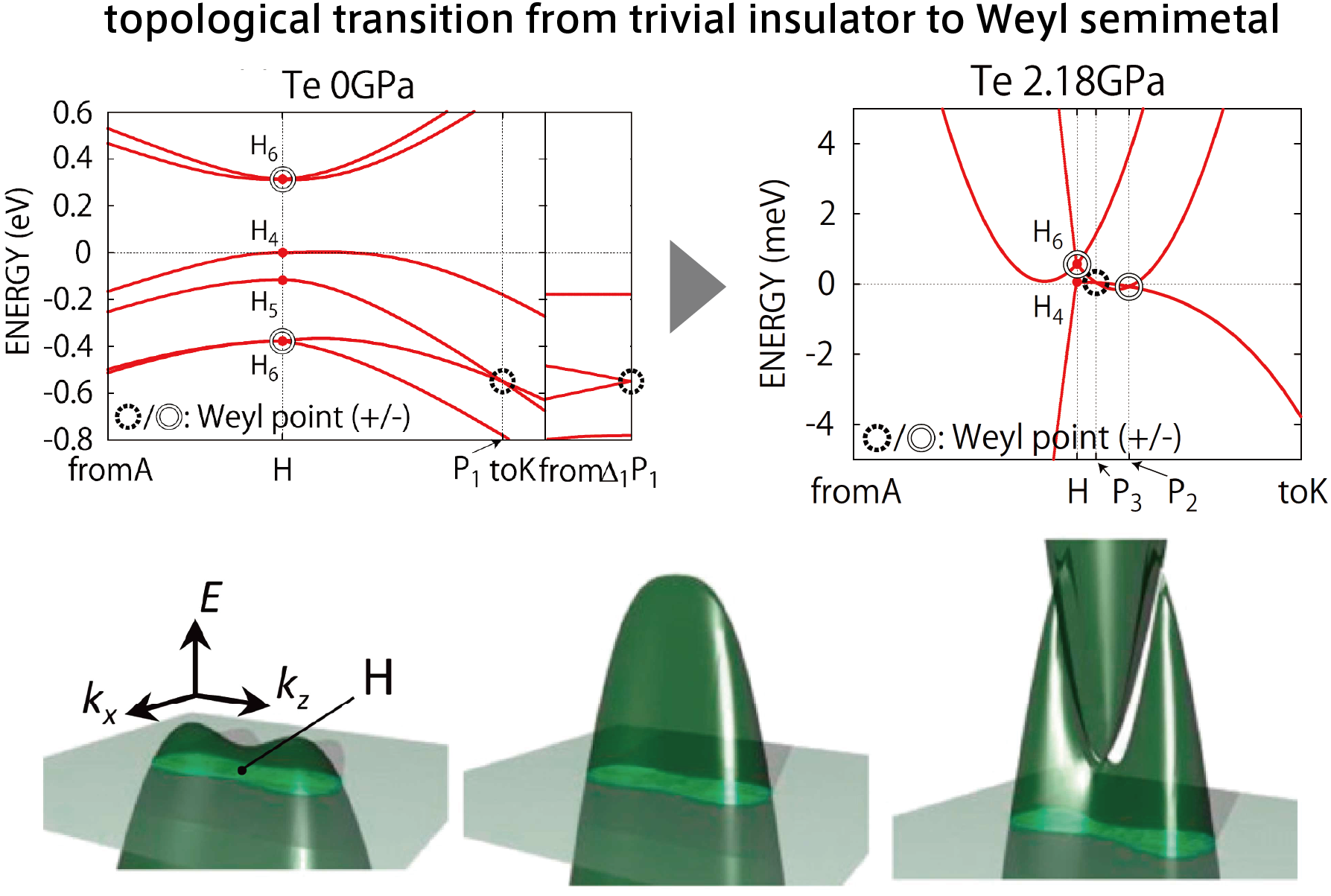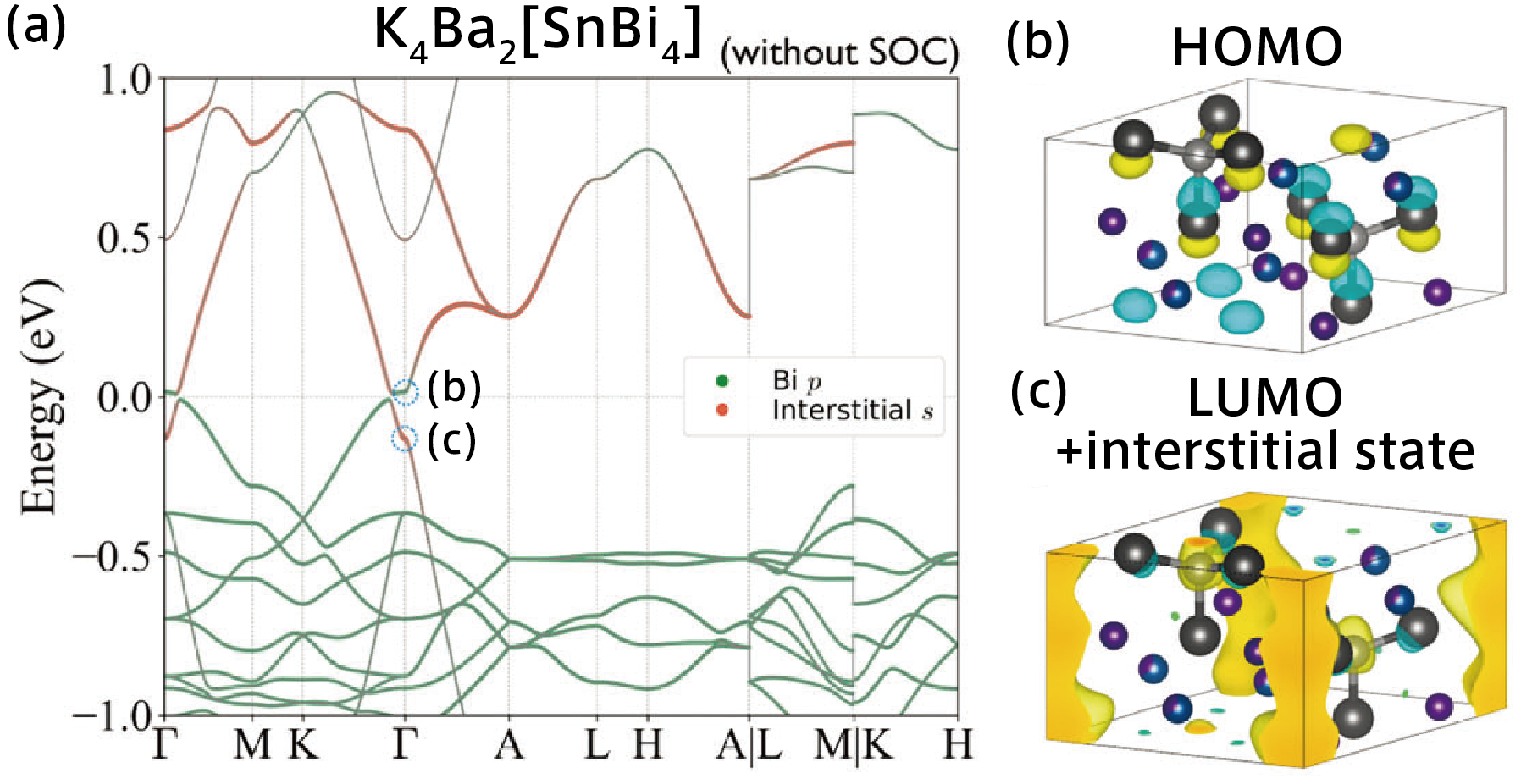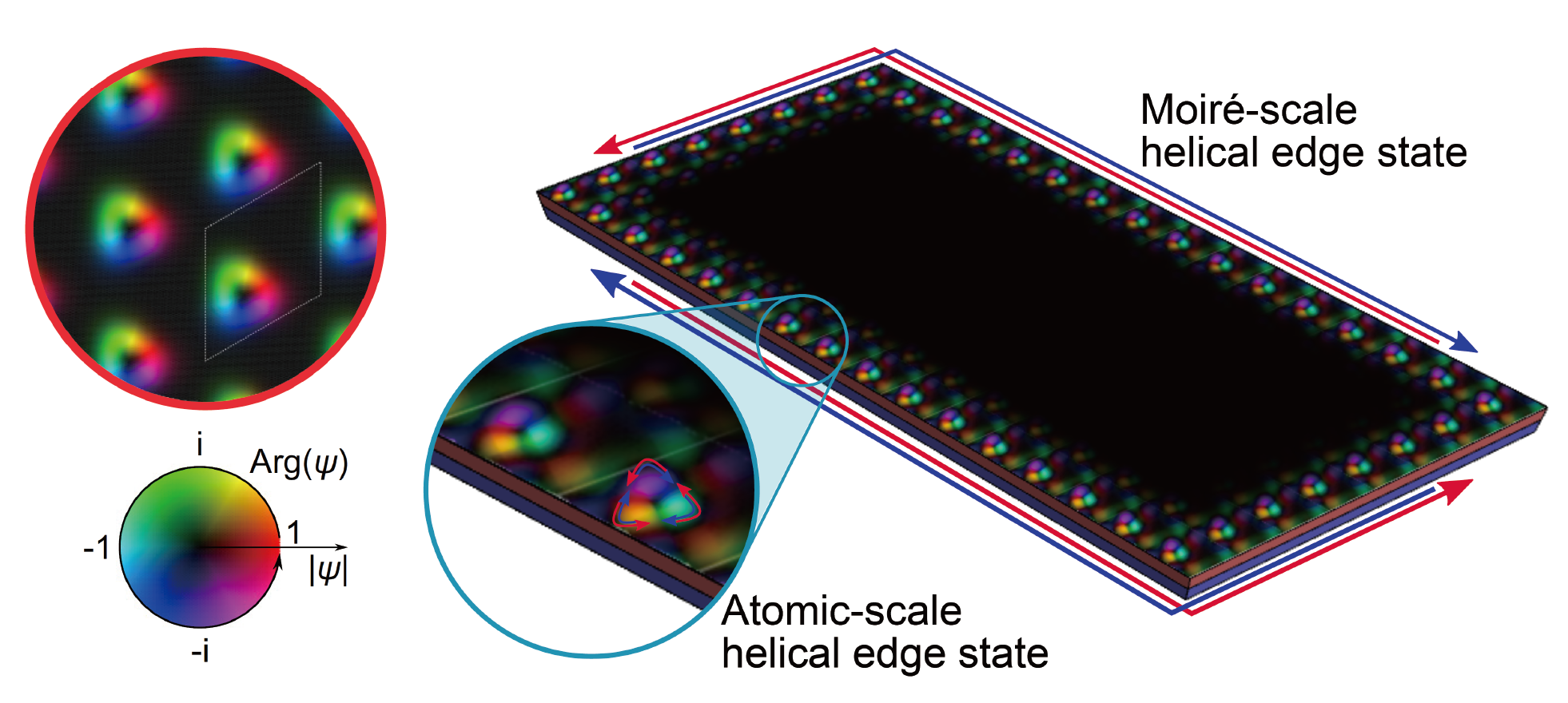Research Interest
Our research is the design of novel materials and their properties by theoretical physics.
In our group, we explore novel materials and their properties using first-principles calculations, which are numerical methods for realistic materials. In particular, we focus on the topological properties of the electronic band structure and search for topological materials with non-trivial properties. We investigate the properties and applications of these unique electronic states. We also include superconducting states and propose the emergence of Majorana fermions. In addition, we develop ab initio methods to treat correlation effects and design a wide range of materials including strongly correlated systems and magnetic systems. We design materials across a wide range of fields, including materials in the chemical and materials fields, such as electrides.
Topological System
- Topological electronic phase
- Topological superconducting phase
- Topological material and application
Ab initio Caluclation
- GW approximation
- Effective model from DFT calc.
- Low-energy solver
Strongly Correlated System
- Magnetic system
- Superconductor
- Hetero structure
Material Science
- Convalent bond & Electride
- Molecule Crystal
- Applied Physics
1. Weyl Node in Tellurium

We have theoretically discovered that triclinic Te becomes a Weyl semimetal with broken spatial inversion symmetry under pressure[1]. This prediction has been experimentally verified through the observation of the de Haas-van Alphen effect [2] and spin-resolved photoemission spectroscopy [3]. Additionally, we have discovered multiple Weyl semimetals from a symmetry perspective [4].
[1] M. Hirayama, S. Ishibashi, R. Okugawa, S. Murakami, and T. Miayake, Weyl Node and Spin Texture in Trigonal Tellurium and Selenium, Phys. Rev. Lett. 114, 206401 (2015).
[2] T. Ideue, M. Hirayama, H. Taiko, T. Takahashi, M. Murase, T. Miyake, S. Murakami, T. Sasagawa, and Y. Iwasa, Pressure-induced topological phase transition in noncentrosymmetric elemental Tellurium, Proc Natl Acad Sci USA 1905524116 (2019).
[3] M. Sakano, M. Hirayama, T. Takahashi, S. Akebi, M. Nakayama, K. Kuroda, K. Taguchi, T. Yoshikawa, K. Miyamoto, T. Okuda, K. Ono, H. Kumigashira, T. Ideue, Y. Iwasa, N. Mitsuishi, K. Ishizaka, S. Shin, T. Miyake, S. Murakami, T. Sasagawa, Takeshi Kondo, Radial spin texture in elemental tellurium with chiral crystal structure, Phys. Rev. Lett. 124, 136404 (2020). (Editors' Suggestion)
[4] S. Murakami, M.Hirayama, R. Okugawa, and T. Miayake, Emergence of topological semimetals in gap closing in semiconductors without inversion symmetry, Sci. Adv. 3, 1602680 (2017).
2. Topological Line Node in fcc Elements
We have theoretically discovered that the face-centered cubic structures of alkaline elements Ca, Sr, and Yb are nodal-line semimetals [1]. In this study, we focused on a similar substance, Ag, and revealed that the origin of the massive spin-splitting extending up to 100 meV in the interface system of Bi/Ag(111) is due to the topological surface state derived from Ag's nodal-line and the covalent bond of Bi pz.
[1] M. Hirayama, R. Okugawa, T. Miayake, and S. Murakami, Topological Dirac nodal lines and surface charges in fcc alkaline earth metals, Nat. Commun. 8, 14022 (2017).

3. Electrides as a New Platform of Topological Materials

Electrides are a group of materials in which electrons e- are trapped in the voids in the crystal, stabilizing the structure as anions. We focus on the fact that electrides possess small work functions and propose that electrides are generally prone to becoming topological materials (i.e., likely to undergo band inversion)[1]. Sc2C (Fig(a)) is a candidate for a topological electride, where the electrons exist at the interstitial region between layers to form a ionic (Sc2C)+2e- state, exhibiting band insulation as shown in Fig(b). In this case, the electron cloud exists centered on the boundary of the unit cell, namely on the cleaved surface, and the polarization possesses the maximum and quantized value (Zak phase=π). To suppress the potential rise due to bulk polarization, a topologically protected topological metallic state originating from the floating state appears on the Sc2C surface (Fig(c)(d)). This non-atomically localized electron cloud has a small work function, enabling high-density electron doping on the material placed on the surface when using Sc2C as a substrate (topological carrier doping). For example, it becomes possible to dope one electron per one Mo site for MoS2 (Fig(e)).We propose a classification of topological electrides and find that Na3Bi, a typical Dirac semimetal, is a topological electride [2]. We also propose the apatite, when made into an electride, could show a higher-order topological insulating phase [2].
[1] M. Hirayama, S. Matsuishi, H. Hosono, and S. Murakami, Electrides as a New Platform of Topological Materials, Phys. Rev. X 8, 031067 (2018).
[2] M. Hirayama, S. Matsuishi, H. Hosono, and S. Murakami, Higher-Order Topological Crystalline Insulating Phase and Quantized Hinge Charge in Topological Electride Apatite, Phys. Rev. Research 2, 043131 (2020).
4. Interstitial-Electron-Induced Topological Molecular Crystals
We succeed in discovering several relativistic topological molecular crystals, such as K4Ba2[SnBi4] [1]. The bands of HOMO (highest occupied molecular orbital) and LUMO (lowest unoccupied molecular orbital) reflect molecular orbitals and have weak wave number dependence, while the band of the interstitial orbitals shows a strong three-dimensional wave number dependence, causing band inversion with the HOMO while mixing with the LUMO. K4Ba2[SnBi4] combines the three characteristics of electrides, relativistic topological materials, and molecular crystals, and possesses composite properties such as a high thermoelectric performance comparable to Bi2Te3.
[1] T. Yu, R. Arita, and M. Hirayama, Interstitial-Electron-Induced Topological Molecular Crystals, Adv. Phys. Res. 2200041 (2022).

5. Twisted Systems

We examine the construction of new moiré electronic states using Bi2Te3, a representative topological material, and its related materials (Sb2Te3, Bi2Se3)[1,2]. By using thin films near the topological phase transition, we can induce phase transitions due to different stacking patterns and build crystals originating from topological edge states. Furthermore, by causing band inversion in the moiré band, we are able to realize moiré topological edge states originating from the bulk's topological edge states.
[1] I. Tateishi and M. Hirayama, Quantum spin Hall effect from multi-scale band inversion in twisted bilayer Bi2(Te1−xSex)3, Phys. Rev. Research 4, 043045 (2022).
[2] I. Tateishi and M. Hirayama, Topological invariant and domain connectivity in moiré materials, Phys. Rev. B 107, 125308 (2023).
6. Ab initio Calculations for Strongly Correlated Systems
We have been developing a method (first-principles downfolding method) that derives an effective model of low-energy degrees of freedom for strongly-correlated electron system, which are difficult to handle with density functional theory, and solves the model using a high-precision numerical calculation method [1-5]. For the first time, our developed method has successfully reproduced the Mott gap and magnetic moment of Cu-based oxide superconductors from first principles [4].
[1] M. Hirayama, T. Miyake, and M. Imada, Derivation of static low-energy effective models by ab inito downfolding method without double counting of Coulomb correlations, Application to SrVO3, FeSe and FeTe: Phys. Rev. B 87, 195144 (2013).
[2] M. Hirayama, T. Miyake, M. Imada, and S. Biermann, Low-energy effective Hamiltonians for correlated electron systems beyond density functional theory, Phys. Rev. B 96, 075102 (2017).
[3] M. Hirayama, Y. Yamaji, T. Misawa, and M. Imada, Ab initio effective Hamiltonians for cuprate superconductors, Phys. Rev. B 98, 134501 (2018).
[4] M. Hirayama, T. Misawa, T. Ohgoe, Y. Yamaji, and M. Imada, Effective Hamiltonian for cuprate superconductors derived from multiscale ab initio scheme with level renormalization, Phys. Rev. B 99, 245155 (2019).
[5] J.-B. Morée, M. Hirayama, M. T. Schmid, Y. Yamaji, and M. Imada, Ab initio low-energy effective Hamiltonians for high-temperature superconducting cuprates Bi2Sr2CuO6, Bi2Sr2CaCu2O8 and CaCuO2, Phys. Rev. B 106, 235150 (2022).

7. Material Design for Topological Systems

We discover a surface metallic state in the insulator FeSi that exhibits strong relativistic effects akin to rare metals [1,2]. FeSi is a nonmagnetic insulator, but its gap originates from the covalent bond between Fe and Si, and a metallic state derived from a huge polarization (π Zak phase) appears on the surface. Despite being a light element, this electronic state exhibits a large Rashba splitting and has been found to transition to a strong magnetic state near room temperature. Additionally, in other material research, we also discover that Pt3Sn is a topological catalyst[3].
[1] Y. Ohtsuka*, N. Kanazawa*, M. Hirayama*, A. Matsui, T. Nomoto, R. Arita, T. Nakajima, T. Hanashima, V. Ukleev, H. Aoki, M. Mogi, K. Fujiwara, A. Tsukazaki, M. Ichikawa, M. Kawasaki, Y. Tokura, Emergence of spin-orbit coupled ferromagnetic surface state derived from Zak phase in a nonmagnetic insulator FeSi, Sci. Adv. 7 eabj0498 (2021).
[2] T. Hori, N. Kanazawa, M. Hirayama, K. Fujiwara, A. Tsukazaki, M. Ichikawa, M. Kawasaki, and Y. Tokura, A Noble-Metal-Free Spintronic System with Proximity-Enhanced Ferromagnetic Topological Surface State of FeSi above Room Temperature, Adv. Mater. 2206801 (2022).
[3] M.-C. Jiang*, G.-Y. Guo, M. Hirayama*, T. Yu, T. Nomoto, and R. Arita, Efficient hydrogen evolution reaction due to topological polarization, Phys. Rev. B 106, 165120 (2022).
8. Material Design for Strongly Correlated Systems
We have combined the downfolding method we developed with material design to theoretically predict candidate materials for high-Tc superconductors based on Ni and Pd [1,2]. One of the predicted Ni oxides has actually been synthesized in experiments, and high-temperature superconductivity is expected to be induced by carrier doping.
[1] Y. Nomura, M. Hirayama, T. Tadano, Y. Yoshimoto, K. Nakamura, and R Arita, Formation of 2D single-component correlated electron system and band engineering in the nickelate superconductor NdNiO2, Phys. Rev. B 100, 205138 (2019).
[2] M. Hirayama, T. Tadano, Y. Nomura, and R. Arita, Materials design of dynamically stable d9 layered nickelates, Phys. Rev. B 101, 075107 (2020).
